
Williamson County is a county in the U.S. state of Texas. As of the 2020 census, its population was 609,017. Its county seat is Georgetown. The county is named for Robert McAlpin Williamson (1804?–1859), a community leader and a veteran of the Battle of San Jacinto.
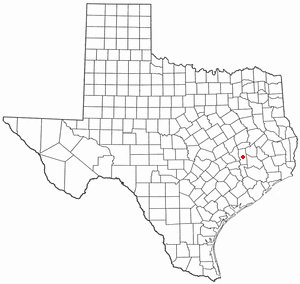
Anderson is a city and county seat of Grimes County, Texas, United States. The population was 193 as of the 2020 census. The town and its surroundings are listed on the National Register of Historic Places as the Anderson Historic District.

Georgetown is a city in Texas and the county seat of Williamson County, Texas, United States. The population was 67,176 at the 2020 census. It is 30 miles (48 km) north of Austin.

The Shackelford County Courthouse Historic District is a historic district in Albany, Texas. It is roughly bounded by South 1st, South 4th, South Jacobs, and South Pecan Streets, centered on the courthouse square. Added to the National Register of Historic Places in 1976, the district includes the Shackelford County Courthouse and a number of surrounding Victorian buildings dating from the late nineteenth and early twentieth centuries.
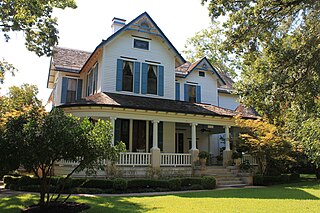
Belford Historic District is a historic district listed on the National Register of Historic Places in Georgetown, Texas. It comprises an eight-block area roughly bounded by University Avenue, the rear property lines to the east of Main Street, 19th Street, and the rear property lines to the west of Austin Street.

The Hood County Courthouse Historic District in Granbury, Hood County, Texas encompasses 12 acres of land. The principal building in and the focal point of the district is the historic Hood County Courthouse built in 1890–1891. Other major buildings include the 1885 Hood County Jailhouse, the 1885 First National Bank Building, the 1891 building which formerly housed the Hood County News, the 1893 Aston-Landers Saloon Building, the 1893 Nutt Brothers Building, and the 1886 Granbury Opea House. On June 5, 1974, the district was added to the National Register of Historic Places. The nomination form called it "one of the most complete nineteenth century courthouse squares in Texas." The district is also recognized as a State Antiquities Landmark and includes several Recorded Texas Historic Landmarks.

The Milam County Courthouse and Jail are two separate historic county governmental buildings located diagonally opposite each other in Cameron, Milam County, Texas. The Milam County Courthouse, located at 100 South Fannin Avenue, was built in 1890–1892, while the Milam County Jail, now known as the Milam County Museum, was built in 1895. On December 20, 1977, they were added to the National Register of Historic Places as a single entry.
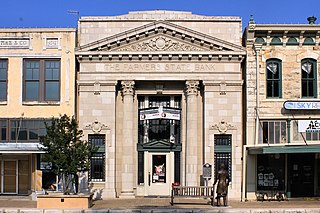
The Williamson Museum is a 501(c)(3) non-profit corporation established in 1997 to collect, preserve and exhibit items relating to the culture and heritage of Williamson County, Texas. The museum is located at 716 S. Austin Ave on the historic square in Georgetown, Texas, in the former Farmers State Bank building.

The Hudspeth County Courthouse is located in the town of Sierra Blanca, the seat of Hudspeth County in the U.S. state of Texas. The courthouse was constructed in 1919 and added to the National Register of Historic Places in 1975. The Texas Historical Commission (THC) has also designated the building as a Recorded Texas Historic Landmark since 1962 and as a State Antiquities Landmark since 1981. The county is named for Claude Benton Hudspeth who served as a U.S. representative from El Paso and previously in both houses of the Texas Legislature where, as a member of the Texas Senate, he was influential in the county's creation.

The Lavaca County Courthouse, in Hallettsville, Texas, is a courthouse which was built in 1897. It was listed on the National Register of Historic Places in 1971.

The Williamson County Courthouse Historic District is an historic district in Georgetown, Texas, listed on the National Register of Historic Places.

The Williamson County Courthouse is a courthouse in Georgetown, Texas, United States. It was designed by Charles Henry Page in 1909, and exhibits Beaux-Arts architecture. During the 2000s, the building underwent a $9 million restoration. The courthouse was rededicated in October 2006.
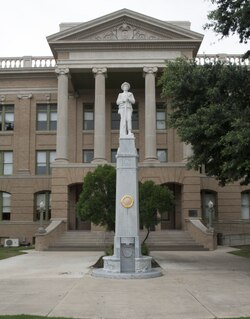
The Confederate Soldiers and Sailors Monument is an outdoor Confederate memorial installed outside the Williamson County Courthouse in Georgetown, Texas, United States.
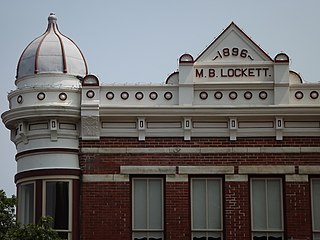
The M.B. Lockett Building is an historic building at 119 West 7th Street in Georgetown, Texas, United States. It is part of the Williamson County Courthouse Historic District.

The Williamson County Jail, or Old Williamson County Jail, is a historic building in Georgetown, Texas, United States. It is part of the Williamson County Courthouse Historic District, and has been designated a Recorded Texas Historic Landmark.

The Georgetown Fire House and Old City Hall is a limestone building located at the intersection of 9th Street and South Main Street in Georgetown, Texas, United States.

The Harris County Courthouse of 1910 is one of the courthouse buildings operated by the Harris County, Texas government, in Downtown Houston. It is in the Classical Revival architectural style and has six stories. Two courtrooms inside are two stories each. It was listed on the National Register of Historic Places on May 13, 1981.

The Fayette County Courthouse and the Fayette County Jail are two historic buildings in La Grange, Texas. The courthouse was designed by James Riely Gordon and built in 1891 by Martin, Byrne and Johnston. The jail was built earlier in 1881 by Fritz Schulte and designed by John Andrewartha and James Wahrenberger. Both buildings were added to the National Register of Historic Places (NRHP) as a single listing on January 23, 1975. and designated a Texas State Antiquities Landmark on January 1,1981 by the Texas Historical Commission (THC). Texas historical marker number 12627 erected in 2001 commemorates the courthouse's status as a Recorded Texas Historic Landmark, marker no. 18757 placed in 2017 does likewise for the jail. On January 16, 2001 both buildings were designated and recorded in the NRHP as contributing properties to the Fayette County Courthouse Square Historic District.

The Fayette County Courthouse Square Historic District in La Grange, Texas is a historic district roughly bounded by Main, Lafayette, Franklin, Colorado, Jefferson, Washington, and Crockett Streets. It was listed on the National Register of Historic Places on January 16, 2001. Two notable buildings in the district are the Fayette County Courthouse and Jail. Forty–seven buildings, three structures and four objects were identified as contributing to the historic nature of the district.


















